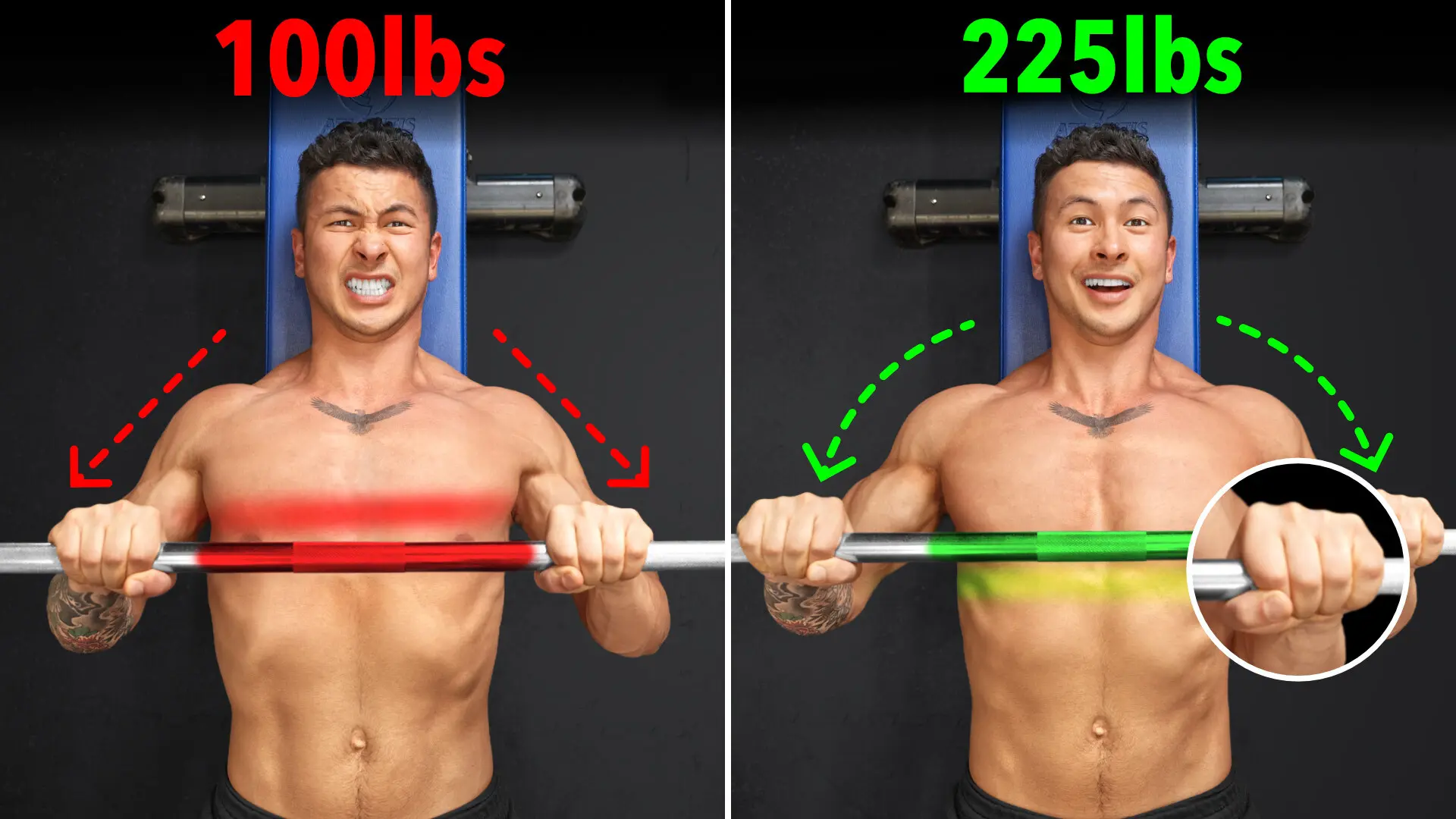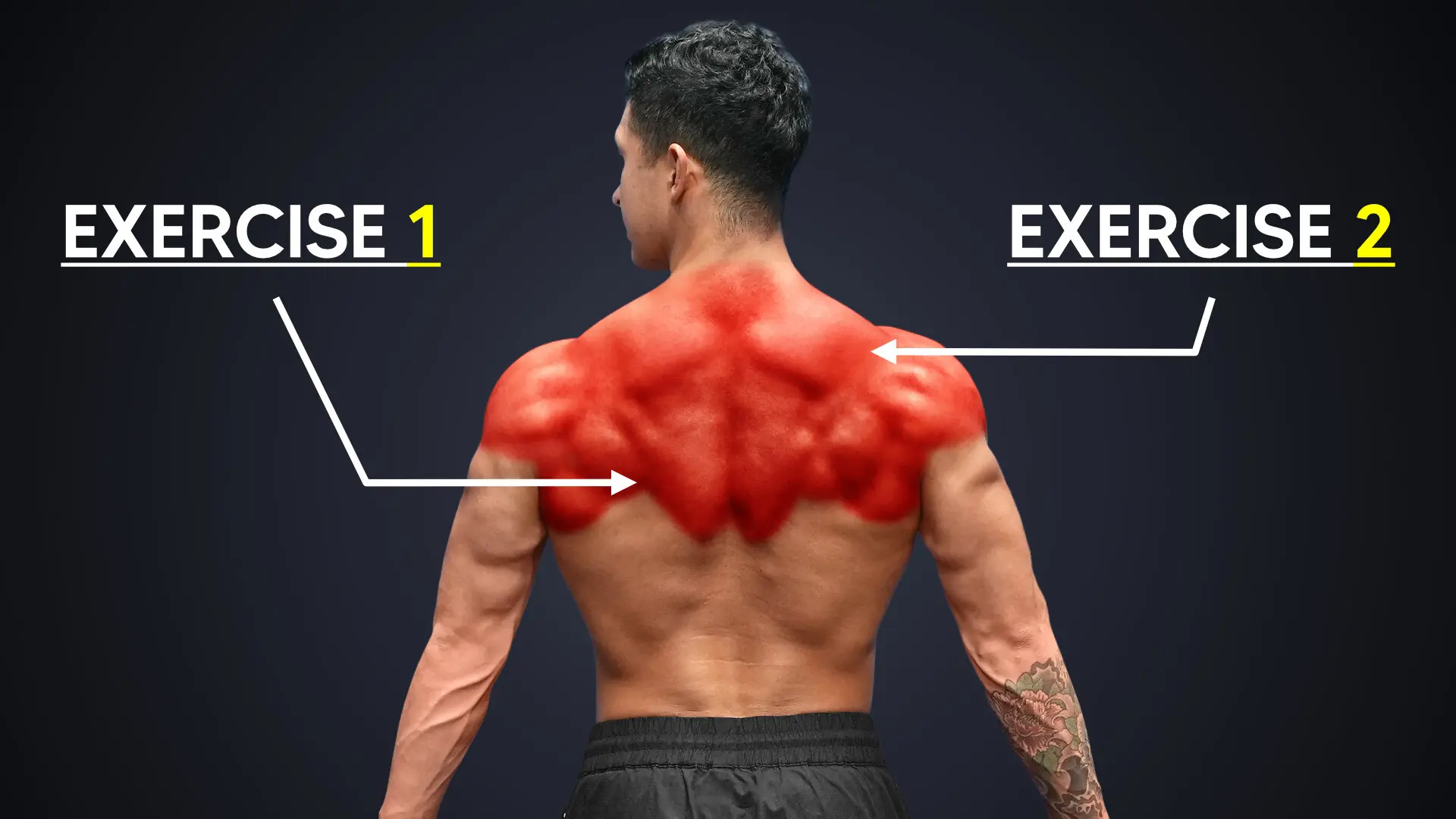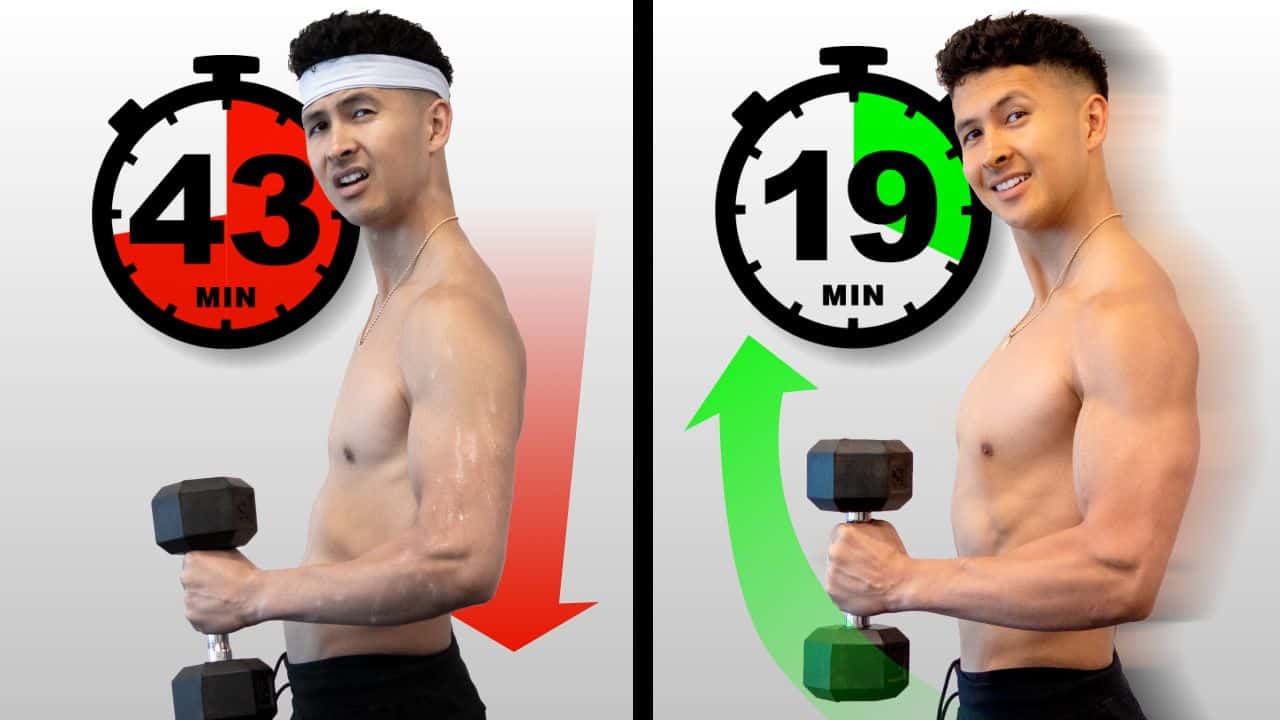
How To Build Muscle With A Fast Workout (More Gains, Half The Time!)
Can you build the same amount of muscle - if not more - despite 'rushing' through your workout? Yes! But you'll have to do a few things correctly. Find out what they are here.
Let's say you're in a crazy rush. You have no time. Or, you're just someone who wants to be really efficient. Then, can you workout ridiculously fast, and build the same amount of muscle as someone who's taking their time? In other words: a person who's lifting, then resting, then lifting? And… Can you build MORE muscle rushing through your workout than someone training normally?... Lifting, then resting, then lifting?
Yes! The answer to both is “you most definitely can”! In this article, I'm going to show you how you can get the same gains (as you're getting now) in literally almost half the time you're spending now - with the clever use of 4 unique training methods. AND... On an even more interesting note, I'm also going to show you how - with 3 of the 4 mentioned methods - 'rushing' through your workout doesn't only just have the potential to produce the same amount of muscle. But even more!
Before that: if you're looking for a training program that'll take care of all the factors necessary for optimal muscle growth (training, nutrition, and even supplementation), no matter how much time you've got in the gym, I've got just the thing for you. Every BWS workout is designed to help you transform your physique in the most time-efficient manner. For more information:
Click the button below to take my analysis quiz to discover the best program for you:
↓
Training Method 1: 3/7 method
Method 1- the 3/7 method. Popularized by a recent 2019 paper, researchers had subjects perform bicep curls for 12 weeks using either the:
- Traditional method - 8 total sets of 6 reps with 2.5 minutes rest between sets OR
- New set configuration - Called the 3/7 method
For the 3/7 method, participants used the same weight but instead performed:
- 3 reps, rested 15 seconds, then
- 4 reps, rested for 15 seconds, then
- 5 reps, rested 15 seconds, then
- 6 reps, rested 15 seconds, and then finally
- 7 reps to finish their set
They then rested for 2.5 minutes and repeated all of this once again.
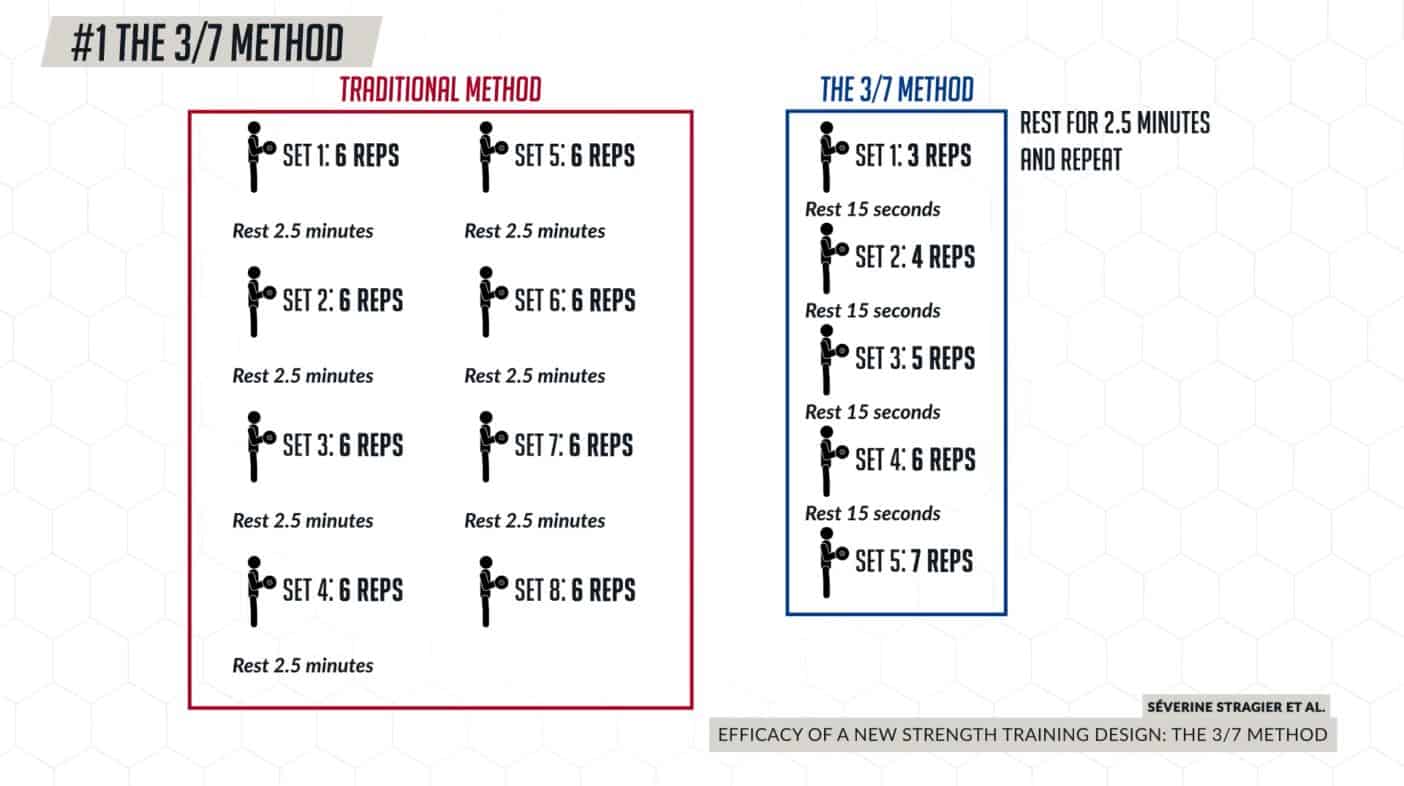
The findings? Researchers found that the 3/7 method resulted in significantly greater gains in both muscle size and strength compared to the traditional group. In fact, the 3/7 method results in nearly double the improvements! Plus, the 3/7 method group finished all their training sessions in less than half the time compared to the traditional group!
Admittedly, this was just one study. It's also worth noting that there are plenty of other variables to consider. Nevertheless. This study still does showcase the potential effectiveness of the 3/7 method when it comes to cutting down your workout time - yet still getting even better results.
How To Implement The 3/7 Method For A Fast, Effective Workout Session
So, how exactly can you implement this? Well, if we base it on this study, 1 round of the 3/7 method appears to be equivalent to 4 sets of traditional training. So, let's say you normally do 4 sets or less in an exercise. That means you can substitute that for 1 round of the 3/7 method. So, for example, let's say you typically do 3 sets of 135 lbs for 10 reps on the bench press. Here's how you'd implement the 3/7 method. First, you perform:
- 3 reps, rest for 15 seconds, then
- 4 reps, rest for 15 seconds, then
- 5 reps, rest for 15 seconds, then
- 6 reps, rest for 15 seconds, and then finally
- 7 reps
The first few sets should be very easy. But by the time you get to the sets of 6 and 7 reps, it should be very difficult. And you should hit failure - or at least come very close to it - by the end of it.
How Fast Can Your Workout Get With The 3/7 Method?
As for time savings? Well, let's take a look at the following workout as an example:
- Bench Press: 3 sets of 10 reps
- Shoulder Press: 3 sets of 10 reps
- Triceps Push Down: 3 sets of 10 reps
- Barbell Row: 3 sets of 10 reps
- Lat Pulldown: 3 sets of 10 reps
- Biceps Curl: 3 sets of 10 reps
Excluding a proper warm-up, assuming that you are:
- Totally focused
- Performing each rep with a controlled 2 sec eccentric & 1 sec concentric AND
- Take exactly 2 minutes of rest between each set and exercise
... Then you can expect this workout to take just under 45 minutes to complete.
But what happens when you apply 1 round of the 3/7 method to each of these exercises? You could take a workout that originally took 43 minutes - and reduce it to just under 24 minutes!
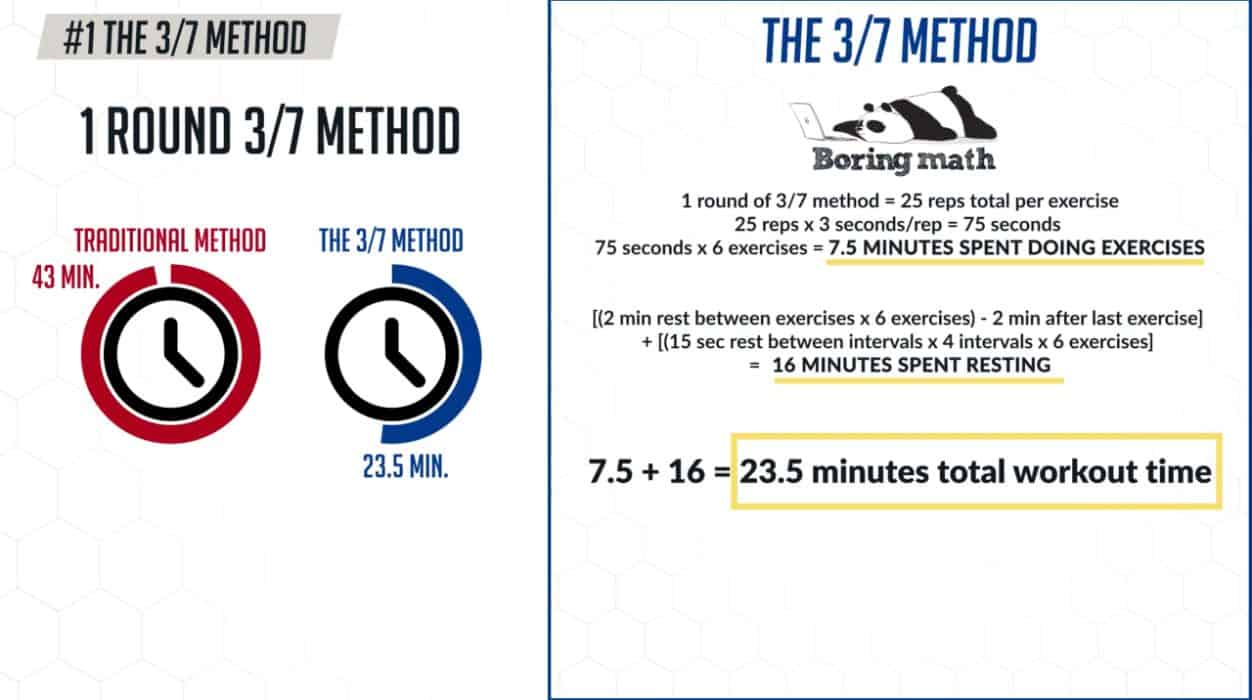
Training Method 2: Rest-Pause Sets
The second training method that you can use for a quick, effective workout at the gym: rest-pause sets. With this method, you won't be performing traditional sets with a standard rest period between each set. Instead, you'll be setting a goal number of reps that you want to achieve. And then basically perform a bunch of 'mini sets' with minimal rest periods in between till you reach the goal number of reps.
For instance, let's say that your goal was to perform 3x10 bicep curls. That would have amounted to a total of 30 reps by the end of it. What you could do instead is to set a goal of 30 reps. Ideally using the same weight. Do as many reps as you can on your first set. Then, instead of resting 1-2 minutes, rest for only 20-30 seconds. Then, go again trying to do as many reps as possible. Your reps will likely drop off significantly in that next set. But that is okay. You simply repeat this process until all 30 repetitions are completed. In total, this might look like sets of 15 reps, 8 reps, 4 reps, and then 3 reps to reach 30 reps in total. Here's what it might look like for you:
- getting 15 reps on the first set
- resting 20 seconds
- getting 8 reps on the second set
- resting 20 seconds
- getting 4 reps on the third set
- resting 20 seconds
- getting 3 reps on the fourth set (which now adds up to 30 reps, which is where you stop)
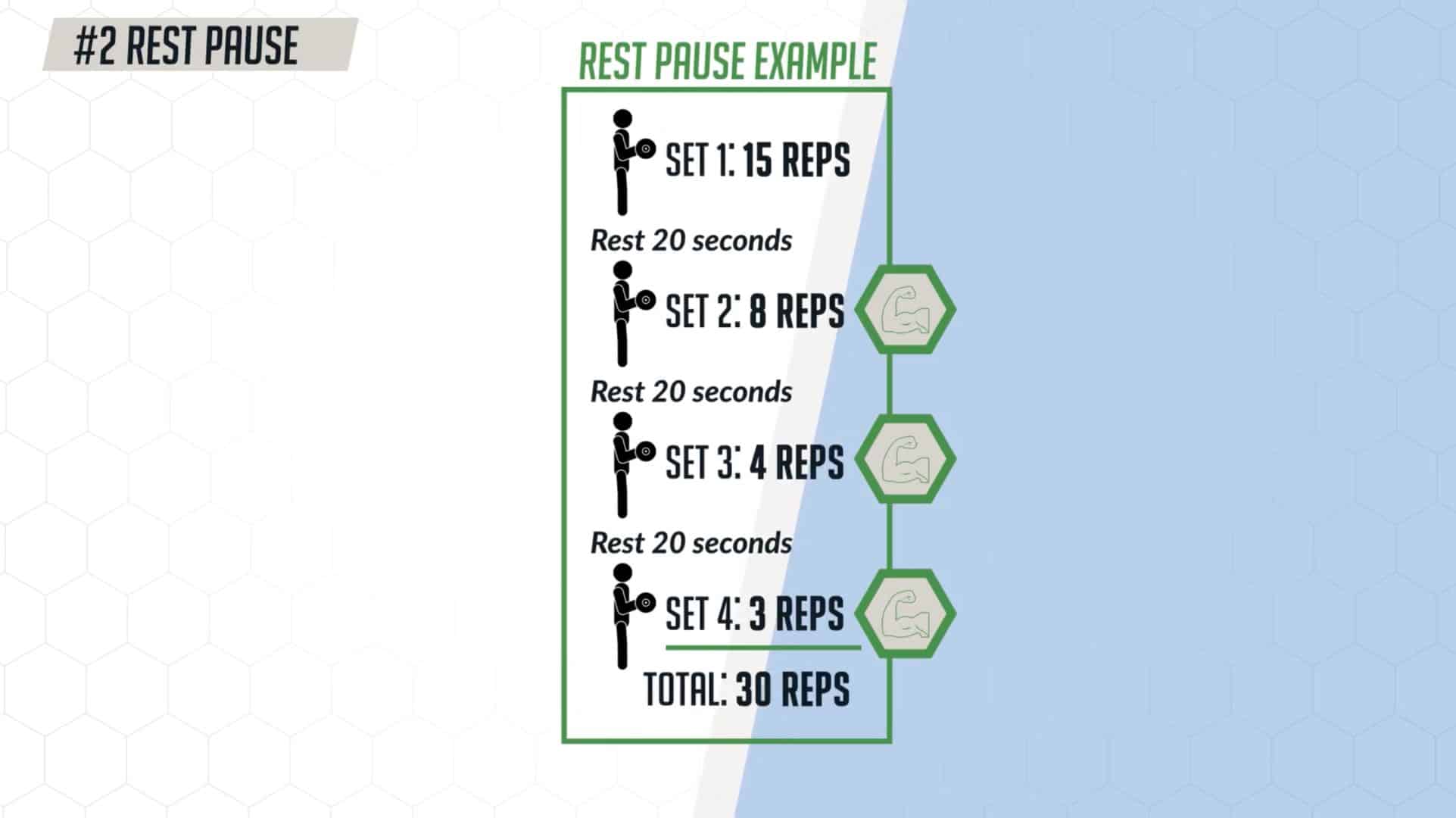
What's The Rationale Behind Using A Rest-Pause Set?
What about the theory behind this particular training method? As we all know, the last few reps of a set where you're really close to failure are the most important to growth. That's because they're the most stimulating. So, by using a rest-pause approach, you are able to repeatedly stress your muscle with these stimulating reps because it’s not fully rested.
And what about effectiveness? You can get an idea of that from a 2019 study. In this study, the researchers had a group of resistance-trained subjects train 4 days per week for 6 weeks using either:
- A traditional approach - Performing all exercises for 3 sets of 6 reps OR
- A rest-pause approach - Performing multiple sets with 20 seconds rest until 18 total reps were completed
The findings? Researchers found that both training methods elicited similar improvements in strength and hypertrophy of the upper body. More than that, however, was that the rest-pause group actually had greater improvements in lower body hypertrophy than the traditional training group! This suggests that you should be able to at least maintain your gains with this approach. And perhaps even augment it!
How Much Time Can You Expect To Save Through Rest-Pause Sets?
Let's look back at our sample workout. Assuming that you're still performing the same exercises for the same number of reps, you could take a workout that originally took 45 minutes, apply rest-pause sets to every exercise - and reduce it down to 19 minutes!
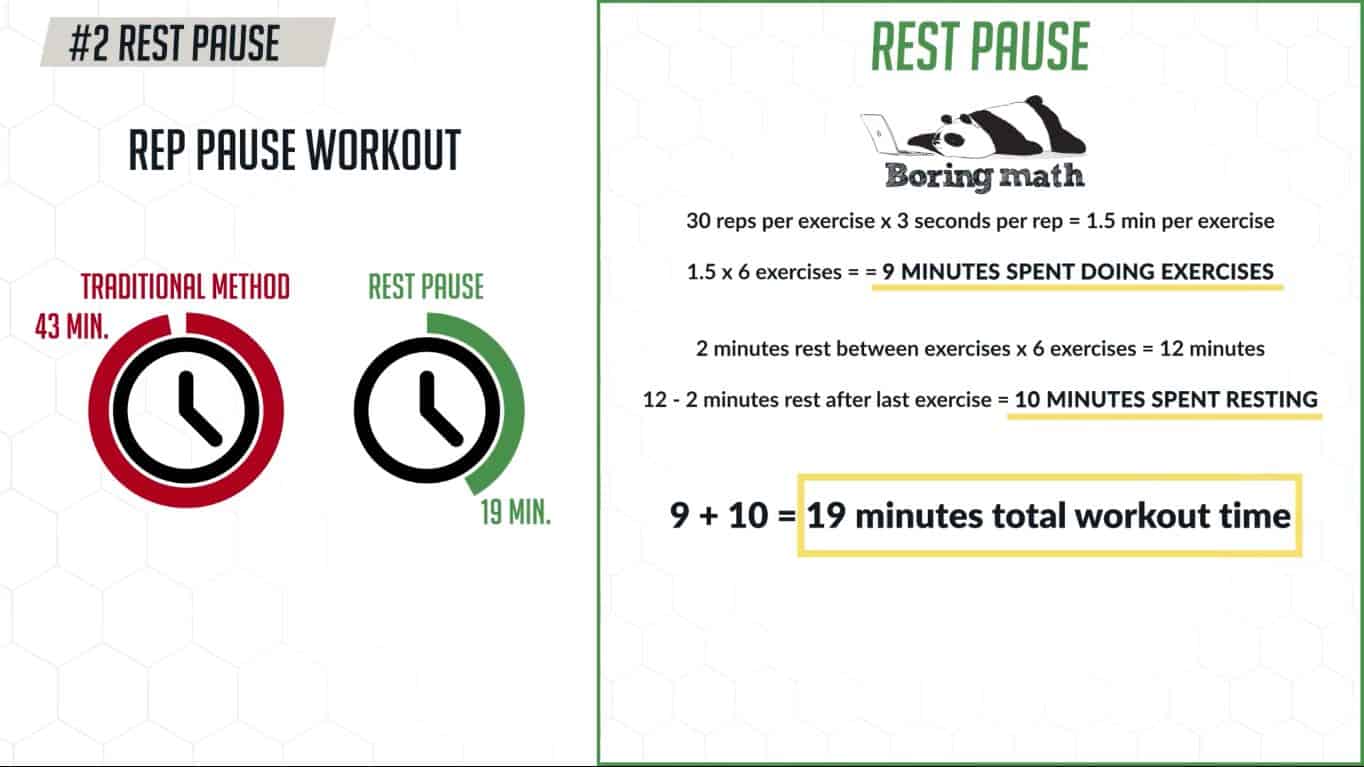
Now, you do want to be careful of applying this to big compound movements. Especially those where form breakdown and fatigue can be dangerous. But overall, including rest-pause sets in your workout routine is an effective strategy to use whenever you’d like to cut down on time without negatively impacting your gains.
Ultimately, there are always modifications you can make to your program to cater to your time constraints. However, picking the right strategy can be tricky (especially when compound movements are involved!)– and this is where our 3-on-1 coaching program comes in. You’ll have a dedicated coach assigned to you (plus myself and a dietitian) to guide you every step of the way, so you never have to feel lost. To find out more:
Click the button below to find out more about the 3-on-1 coaching program:
↓
Training Method 3: Drop Sets
Method 3 - drop sets. Let’s say you typically do 3 sets of biceps curls with 40 lbs in each hand and 2 minutes rest in between sets. With drop sets, you’d perform the first set the exact same way as you normally would. And with the same weight. But after completing it, instead of resting, you decrease the weight by 10-20%. Then, perform another set very close or all the way to failure. After that set, you decrease the weight again by 10-20% and do this once again. You repeat this process for a minimum of the number of sets that you would normally do. In this case, that would be at least 3.
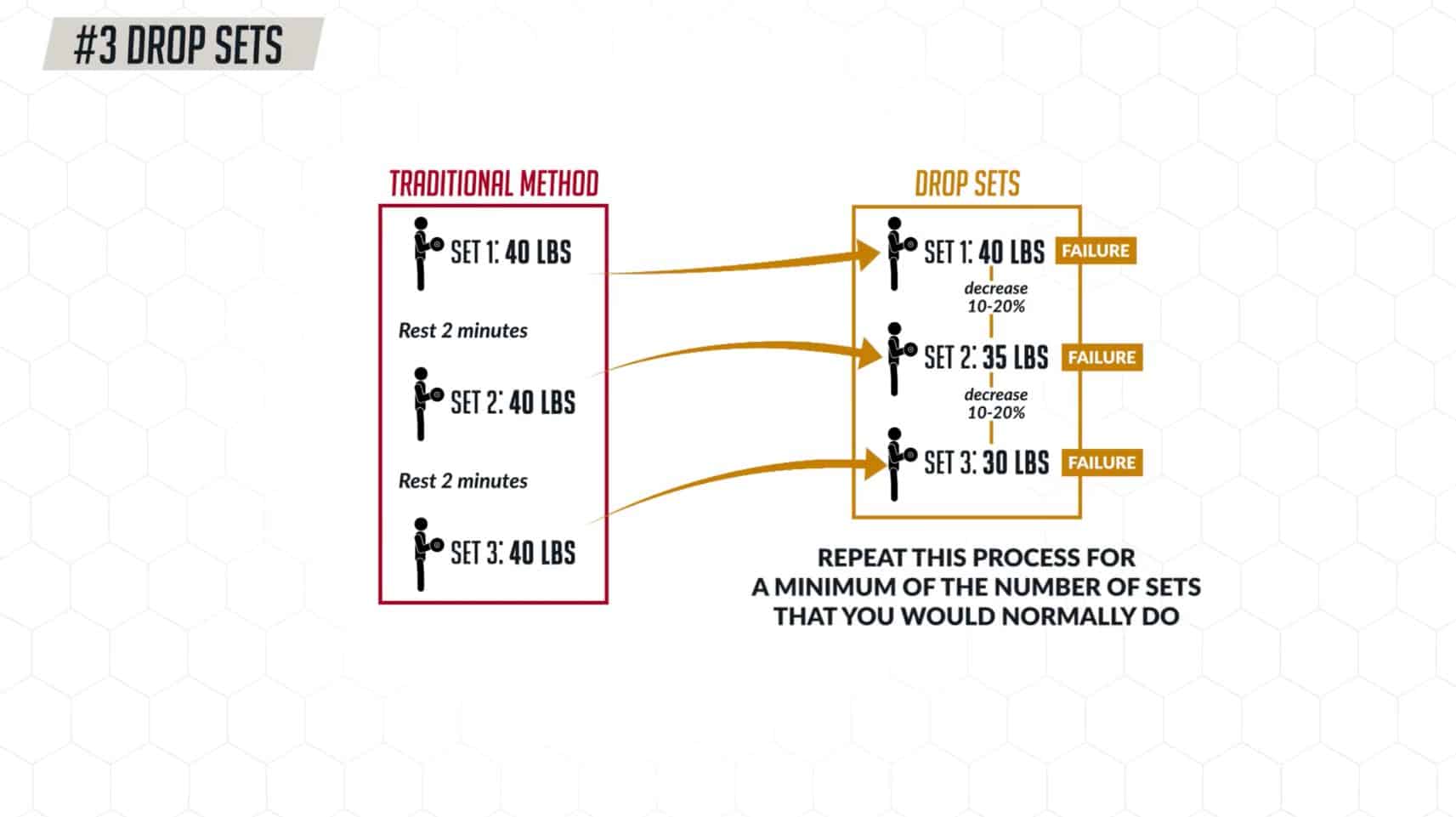
Illustrating its effectiveness is a 2017 study. Over the course of 8 weeks, researchers had participants perform biceps curls using either:
- 3 sets to failure with 90 seconds rest between sets OR
- 5 sets with the dropset method by dropping the starting weight by about 10% each set, with no rest between sets
The findings? Both training methods elicited similar gains in hypertrophy and strength with no differences between groups. However, the group using drop sets finished each training session in less than 1/3 the time as the traditional training group!
A 2018 study employed a similar protocol - but using the tricep pushdown instead. Again, the researchers found that both groups gained the same amount of muscle and strength. And that the group using drop sets finished each session in less than half the time as the traditional training group. Meaning that with drop sets you can significantly cut down your workout time without sacrificing your gains.
How To Implement Drop Sets Into Your Training
So, how can you implement this? Well, at a minimum, you want to ensure that you use the same number of drop sets as total sets in your normal workouts. For example, let's say you normally do 3 sets for an exercise. That means that you'd want to do at least 3 drop sets.
Once again, let's look back at our example workout. You normally do 3 sets of 10 on a barbell curl using 20 lbs on each side. What you could do instead is:
- Perform your first set to failure using that weight
- Then reduce the weight by 20% by stripping off 5 lbs from each side
- And immediately perform another set to failure
- Then reduce the weight by another 5 lbs each side one more time
- And perform your final set to failure
How Fast Can Your Workout Get With Drop Sets?
As for how much time this could save you, if we look back at our example workout, while still performing the same exercises you could take a workout that originally took 45 minutes - and reduce it to around 19 minutes!
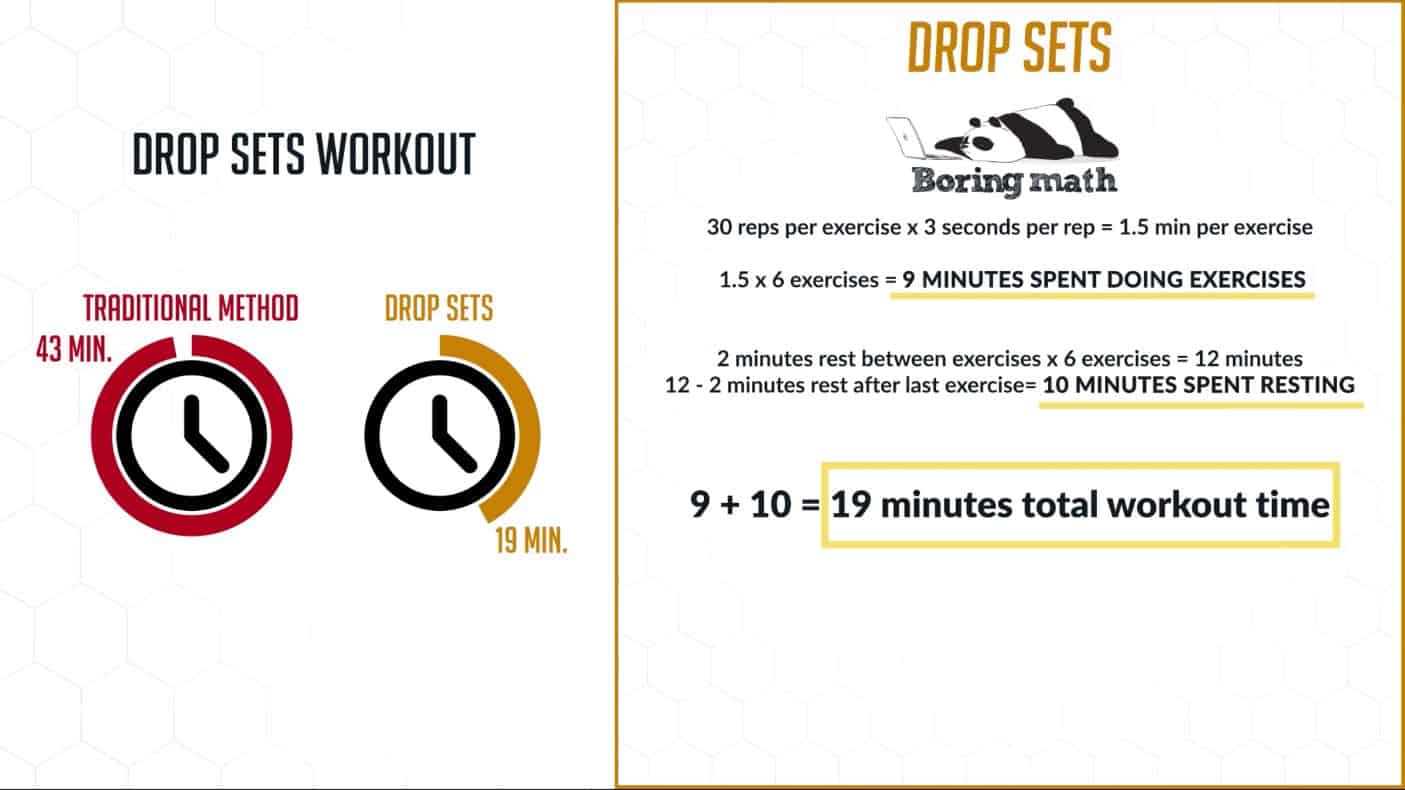
Training Method 4: Supersets
Last but not least, method 4: supersets. But wait. What is a superset? A superset is where you perform two different exercises immediately back to back, take a short rest, and then repeat. By doing this, you are essentially removing half of your typical rest times from your workout. However, many people are not doing them right. And this ultimately hurts their workouts by using the wrong exercises for their supersets.
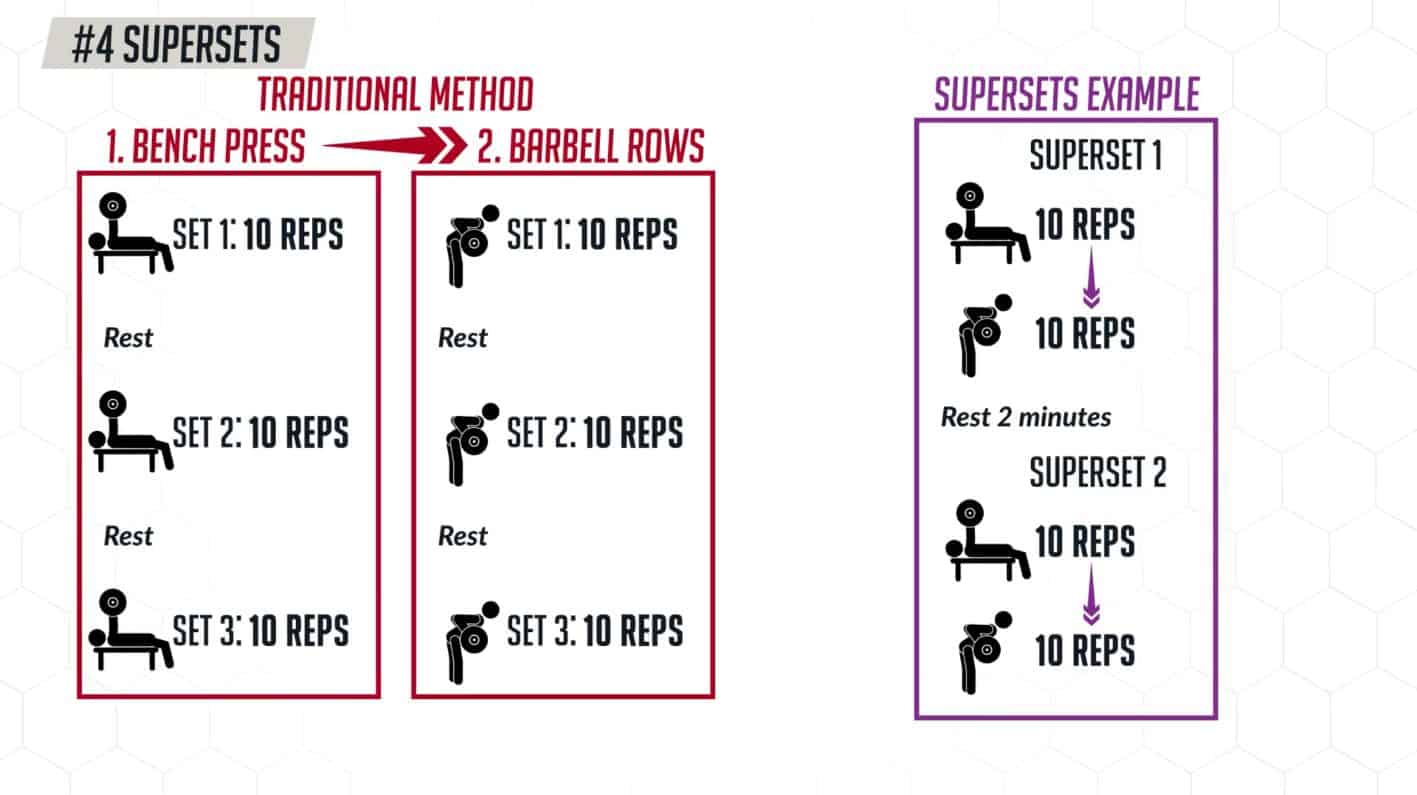
This is because numerous studies have found supersets training the same muscle to be less than ideal for optimizing gains. For example, a 2019 study had participants perform 5 sets of bench press and 5 sets of incline bench press as a superset. They then compared that with the traditional method of using standard rest periods between sets and finishing one exercise before moving onto the next. The results? When subjects used the superset method, they:
- Performed 15% fewer reps when compared to the traditional training method AND
- Experienced a significant reduction in muscle activation
... Both of which would likely lead to not as much growth over time!
Your Supersets Should Target Opposing Muscle Groups
So, what should you do instead? Well, research is pretty clear that supersets training opposing muscle groups, such as chest and back, is the way to go.
Illustrating this is a 2017 study. Here, researchers had participants perform a superset of 3 sets of bench press and 3 sets of seated rows. Then, compared this to their performance using a traditional training approach. What they found is that in addition to the traditional training approach taking about twice as long to complete, performing the exercises as a superset led to an increase in muscle activation of the chest and back muscles and on average a 13% increase in their workout performance!
Another paper showed similar results. More specifically, the researchers found that performing a superset of leg curls immediately followed by leg extensions significantly increased:
- Quadriceps muscle activation AND
- The amount of reps that could be performed
... When compared to just doing the leg extensions alone.
As for the reasoning behind this, there may be a benefit in activating the opposing muscles of a muscle group prior to training it. And, although counterintuitive, supersets training opposing muscle groups actually allow the muscle to rest even LONGER than when compared to traditional sets.
Now, it does take a little bit of time to switch exercises. But for the best results, research indicates you want to do this as fast as possible. At least under 30 seconds.
How Much Time Can You Save With Supersets?
As for time savings? If you apply supersets to the example workout shown earlier by using opposing muscle groups and movement patterns like so:
Superset Workout:
Superset 1*:
Bench Press (horizontal press - chest) < --- > Barbell Row (horizontal row - back)
Superset 2*:
Shoulder Press (vertical press - shoulders) < -- > Lat Pulldown (vertical row - back)
Superset 3*:
Biceps Curl (biceps)
Triceps Push Down (triceps)
*Perform each superset 3 times with 2 minutes rest between each superset
You can take a workout that originally lasted 45 minutes and cut it down to just over half at 25 minutes while potentially boosting your performance in the process.
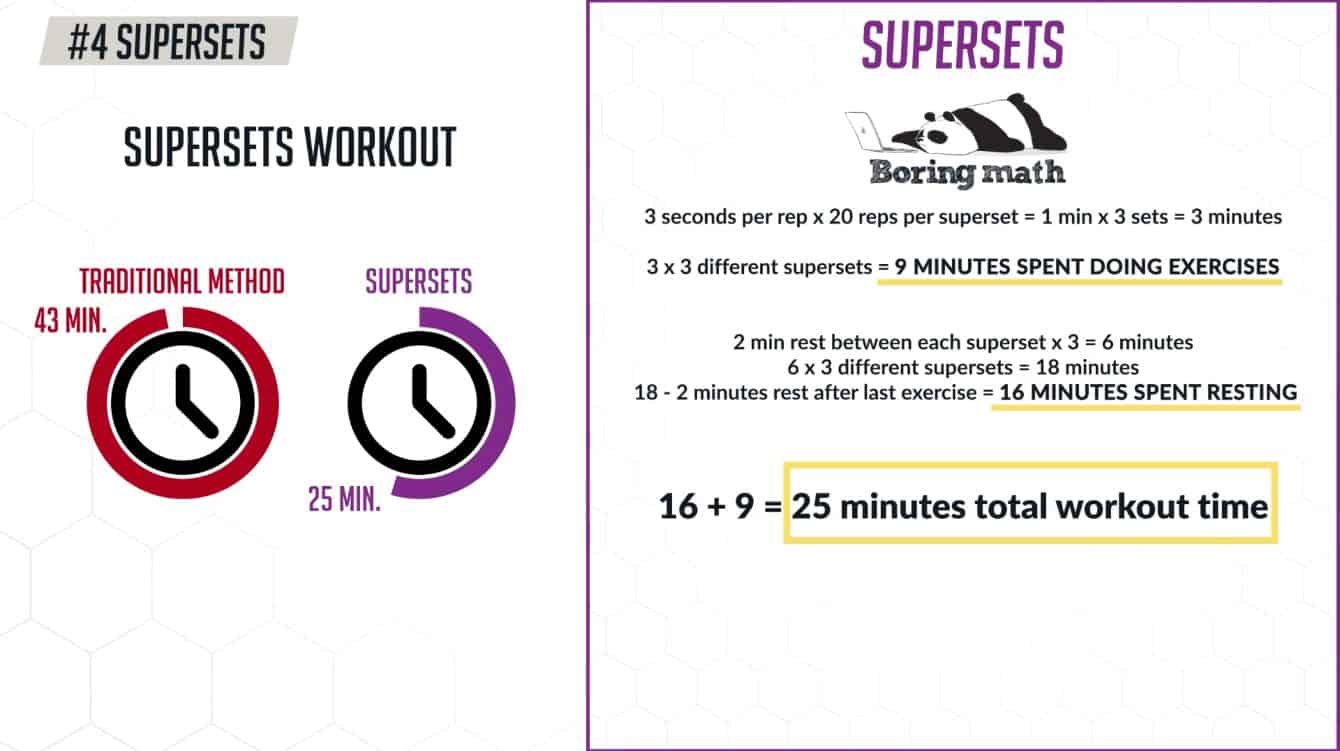
How To Build More Muscle With A Fast Workout: Takeaway
I’d suggest playing around with these 4 methods in your routine. See how you like them. However, just be wary of their inclusion on big compound exercises where form breakdown can pose risks. This is especially when you’re training to failure. But, overall, hopefully, you were able to see that if you’re in a rush and want a quick, effective workout or just want to maximize your efficiency, then you have plenty of options to do so. At the same time, though, just keep in mind that in order for these methods and your overall training to be effective, you need to pay attention to the little details. As that’s what makes all the difference.
And for a step by step program that shows you exactly how to train week after week to maximize your gains, build lean muscle, and strip off stubborn fat in the most efficient way possible then:
Click the button below to take my analysis quiz to discover the best program for you:
↓
By the way, here’s the article summed up into a YouTube video:


